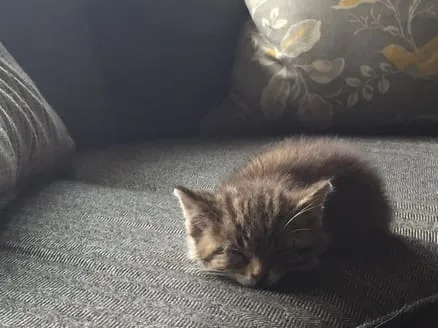Vaccines

Rabies: Rabies is required by Pennsylvania law. Rabies is a virus that affects the brain causing mental disorientation, aggression, and death. Rabies affects all mammals, including humans, and is always fatal. Even if your cat is indoor only, there are many instances where you could encounter an infected mammal, such as mice, bats, or rabbits. This vaccine is initially given at 12 weeks of age or older then given as a yearly booster.
FVRCP: This is a combination vaccine that protects against three harmful, airborne viruses, Rhinotracheitis (Feline Herpes), Calicivirus, and Panleukopenia (Kitty Distemper). This vaccine is initially given at 8 weeks old and then a booster vaccine given every 3-4 weeks until the kitten is 16-18 weeks of age. It is then given as a yearly booster.
Feline Leukemia (FeLv): This viral infection can weaken your cat’s immune system, which can prevent your cat from being able to fight other common infections. Feline Leukemia will also cause cancer and blood disorders. Unfortunately, there is no cure for Feline Leukemia, so prevention is strongly recommended, especially if your cat leads an outdoor, or indoor/outdoor lifestyle, or lives with another pet that does. This virus is shed in a cat’s bodily fluids and excretions. A cat could contract it from a bite, mutual grooming, shared litter boxes, or through nursing from their mother. This vaccine is usually given around 12 weeks of age and a booster given in 3-4 weeks, and then every year thereafter. Testing for this infection is available and encouraged when bringing your new cat into your household.
Litterbox FAQ
How many litter boxes should I have in my home?
We recommend that you have one litter box per cat plus one extra. For example: If you have one cat, you should have two litter boxes. If you have two cats you could have three litter boxes.
Where should I put my litter boxes?
Your litter boxes should be placed in low-traffic areas, and on varying floors in your home, as well as in different areas of the floor. It is recommended that if you have a two-floor home with two cats that one litter box goes on one level and two litter boxes are placed in two different areas on the other level. Be mindful of what the litter box is placed next to. If it is next to the dryer, the buzzer may be startling to your cat.
How often should I clean my litter?
We recommend cleaning your litter every day to every other day. You should dump your litter and scrub your litter boxes at least once monthly and replace your litter boxes every 3 years.
What kind of litter should I use?
While it is really the owner's choice when it comes to picking a litter, cats generally prefer litter that they can easily cover any urine or excrement with. This is typically a clay, scoopable, low-dust, unscented litter. *Pregnant women & anyone with a compromised immune system should avoid scooping litter boxes due to the parasite Toxoplasma*
Common Toxins
1. DOG flea & tick preventatives – always make sure the preventative you are applying to your cat is labeled for cats!
2. GENERIC FLEA AND TICK PREVENTIONS EVEN WHEN THEY ARE MADE FOR CATS OFTEN CAUSE ADVERSE REACTIONS.
3. Human or veterinary drugs, such as acetaminophen, ibuprofen, aspirin, antidepressants or any other non-veterinarian prescribed NSAID.
4. Poisonous Plants: Azaleas, Rhododendrons, LILIES!
5. Household Cleaners
Other: Glow Sticks, liquid potpourri, crystal lamps
Preventatives
Fleas and ticks are not only creepy and annoying but can transmit various diseases to your cat and your family. These parasites, despite popular belief, can be found in the environment and contracted by your cat all year-round, and do not die when the ground freezes. Fleas especially love the warmth of your home and a free meal from your pet! Ticks are hardy and lie in wait for the perfect moment to attach to your pet and you!
The most important tip for flea & tick preventatives is that the most effective and reliable products are provided to you by your veterinarian by prescription. While internet retailers do carry prescription products, you can trust that your veterinarian will carry trusted, true, and tested products. Below is more interesting information about preventatives:
- Over-the-counter products range from ineffective to down-right dangerous to your pet.
- Beware of counterfeit products from third-party sellers on websites such as E-bay.
- Online sources do not always store and transfer the products properly, making them less effective.
- The companies that make the preventatives sold by your vet usually carry guarantees and offer money-saving rebates or rewards programs!
Flea & Tick prevention is not only beneficial for keeping creepy crawlies off your cat’s fur, but also out of your cat’s intestines as well! Cat’s love to hunt whether it’s your feet, their cat toys, or a mouse that wants to live in your house! Although hunting is natural to your cat, eating their prey can cause parasites, such as roundworms to take up residence in your cat’s intestines. Even eating as little as one flea when your cat is doing their normal grooming could invite a tapeworm into their body! What is great about flea & tick prevention, such as Revolution + is that while it battles fleas and ticks on the outside, it also prevents intestinal parasites from settling on the inside.
On a final note, it is important to always use a preventative that is labeled for cats because treatments for dogs can be ineffective or toxic to your cat!!
Food Recommendations
Kittens should be weaned, as naturally as possible between five to seven weeks old. When your kitten is completely weaned, they should get all the nutrients they need from a specially formulated kitten food.
Selecting a kitten food can be VERY confusing. So here are a few tips to help!
- Pick a food that meets AAFCO (Association of American Feed Control Officials) standards, which is a non-profit that investigates ingredients, provides food label standardization & offers a proficiency testing program.
- Look for a Brand that performs its own food trials. Don’t be too wary of brands that have made recalls in the past. This is more from diligent testing that protects both your cat and you!
- Don’t be fooled by marketing buzzwords like grain-fee, all-natural, no by-products, etc. These brands seem to be more worried about selling food than nurturing your growing kitten.
- By-products in a pet food are defined as any non-muscle portion of an animal. These non-muscle parts, like the liver, of an animal can be very beneficial to a growing kitten, and provide them with a whole host of beneficial nutrients.
- Raw diets are strongly discouraged.
- Our doctors are a great source of information and generally recommend, and personally use, these three brands:
When it comes to food, the healthiest thing you will do for your dog is keep them from overeating and becoming overweight. Pet obesity is the number one health problem for our pets. Therefore, we recommend measured feedings, and not free feeding.
Ribbons, Strings, & Pretty Things
Cats love to play! But be careful what you let your cat play with! String, ribbon, and tinsel are extremely damaging to your cat’s digestive system! If any of these items are swallowed by your cat, they could lead to serious surgery or even death! Watch out for rubber bands and hair ties too. When cat’s play they are mimicking hunting behaviors and tend to gobble down what they catch. Try providing your cat with plenty of fun toys, such as crinkle balls or cloth mice.
Introducing your new cat to your home & the world!
When it comes to bringing your new fur kid home for the first time, you may notice they are nervous. Often your new cat may not want to eat for the first 24 hours. This is normal, but you can take steps to reduce your cat’s stress. First, keep your cat in a quiet place like a spare bedroom/bathroom with their litter box, water, and food easily accessible. You can try Feliway diffusers which have been known to reduce stress. These diffusers emit a calming pheromone derived from a cat’s facial pheromone, which they use to mark their territory. Let your cat slowly warm up to the first room, and then introduce them to the rest of the house. Soon it’ll feel like your cat is the true owner of the house! This is also a good time to start developing good crate habits. Start incorporating your cat’s carrier into their normal resting & playing areas. Soon your cat will see the carrier as something they sleep or play in and won’t be stressed by the sight of it. So when it’s time for your cat’s first vet visit, your cat will willingly hop into the carrier for you.
We can’t wait to see you and your new kitten for their first veterinarian appointment! We will be excited to assist you with any questions and concerns you may have ranging from cat behavior to preventative care! Our staff will especially be happy to provide lots of cuddles too!



